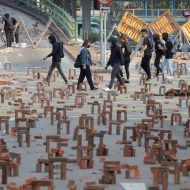
Logistical Requirements. Logistical requirements of the clandestine organization are rudimentary and simple when compared to a conventional force of similar size. These requirements, in general, consist of—
- Living necessities, such as housing, food, clothing, shoes, shelter, and medical equipment.
- Basic equipment for the conduct of insurgent operations. Major categories are—fuel, lighters, glass bottles, crowbars, rocks, bricks, paint, glue, etc.
- Equipment for producing and circulating insurgent media—computers, printers, ink, paper, wheat-paste, etc.
- Secure transportation to enable operatives to accomplish their objectives and remain undetected.
- A basic medical system to care for the sick and wounded.
- A legal support base, including fund raising efforts and relationships with lawyers.
Transportation. The securing of safe and reliable transportation is a key logistical issue. While walking, taking public transit, or riding bicycles can be used in small-scale operations, or for specific tasks, automobiles are often necessary for larger-scale operations. Operatives must be careful not to leave a pattern that can be detected by state forces, i.e. the regular use of specific vehicles. Therefore, operatives must have a large pool of vehicles at their disposal.
Storage. Concentration of supplies is a security risk. Supplies in excess of current requirements can be cached in a number of isolated locations to minimize the risk of discovery. Dispersal of caches through the operational environment also permits a high degree of operational flexibility. Items are carefully hidden so as to appear as if part of the normal landscape. The cache should be readily accessible to the user.
Medical System. The duty of medical personnel in the insurgent struggle is to render efficient evacuation and treatment of insurgent casualties. Both insurgents and auxiliary forces staff the medical system in the area of operation.
- Organization. The organization of the medical system consists essentially of three sections—the aid station, which is mobile, and is charged with the immediate care and evacuation of casualties; the hospital, which performs treatment of casualties and coordinates medical resupply and training; and lastly, the convalescent section, which cares for patients who require rest and a minimum of active medical attention before their return to fighting. The convalescent station is not located near the hospital, as this increases the size of the installation and thus the security risk.
- Evacuation. Every effort is made by the aid station to evacuate wounded insurgents from the scene of action. However, enemy operations may prevent movement to the insurgent hospital. In this event, the wounded are hidden in a secret location and the local auxiliary unit is notified. The local auxiliaries then care for and hide the wounded until they can be safely transported to the insurgent hospital or convalescent station.
- Expansion of Medical System. As the insurgency grows, it is more efficient from a medical standpoint to establish a centralized system to provide advanced medical care. Since this type of installation may be fairly large and may have sizable amounts of equipment, its mobility will suffer. For that reason it is located in a relatively isolated area away from insurgent operations. To prevent the hospital from becoming so large that it attracts undue attention, certain actions are taken. First, as more medical personnel, supplies, and equipment become available, additional hospitals are established in other areas. Second, as soon as possible, a patient is transferred to a convalescent home to complete her recovery.
